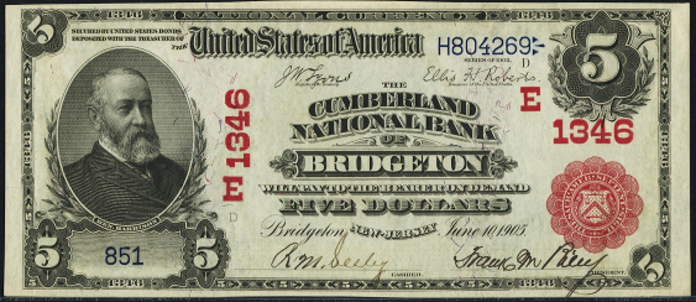Five Dollar Notes › Nationals › 1902 Five Dollar National Bank Notes › Indiana Charters › 1902 $5 Princeton Indiana Farmers National Bank
Get Value Now
| Item | Info |
|---|---|
| Series | 1902 |
| Charter | #9463 Farmers National Bank of Princeton, Indiana |
| Year Chartered | 1909, 320 Banks Chartered |
| City Info | Princeton is a city in Patoka Township, Gibson County, Indiana, United States. The population was 8,644 at the 2010 census, and it is part of the greater Evansville, Indiana, Metropolitan Area. The city is the county seat of and the largest city in Gibson County. Source: Wikipedia |
| Similar Cities | 17 banks with similar city. First 12 below: 1. Princeton, Illinois - First National Bank 2. Princeton, New Jersey - Princeton National Bank 3. Princeton, Indiana - Gibson County National Bank 4. Princeton, Illinois - Farmer's National Bank 5. Princeton, Indiana - Peoples National Bank 6. Princeton, Illinois - Citizens National Bank 7. Princeton, Kentucky - First National Bank 8. Princeton, Minnesota - First National Bank 9. Princeton, New Jersey - First National Bank 10. Princeton, Kentucky - Farmers National Bank 11. Princeton, Wisconsin - First National Bank 12. Princeton, Minnesota - First National Bank |
| Seal Varieties | Red, Blue |
| See Also | If your note doesn't match try: 1. 1907 $5 Legal Tender 2. 1899 $5 Silver Certificates |
| Other Info | 1. Value depends on notes known for charter, condition and market demand. |
| Neat Fact | Full and partial sheets of National Bank Notes are known to exists. Families of bank officials, particularly those who signed the notes, kept them as keepsakes. Some sheets are extremely valuable. Others are more common. |
No Obligations Offers and Appraisals
Please submit a good photo or scan. It will be identified and evaluated. Understand there may be subtle differences between the image you see above and your note. Signatures, design, markings and note condition will determine the offer price. Notes in Uncirculated or better condition receive the best offers.
Appraisals can be estimated for wholesale and retail prices. Wholesale is what dealers typically pay. Retail is what a collector might pay. Retail is slightly higher in most cases.
Please visit this page for USA Paper Money Reference. Do not treat this page as a reference guide, it is for appraisal and acquisition purposes only.
